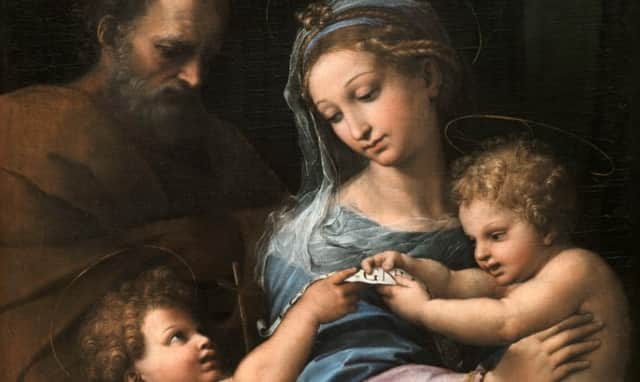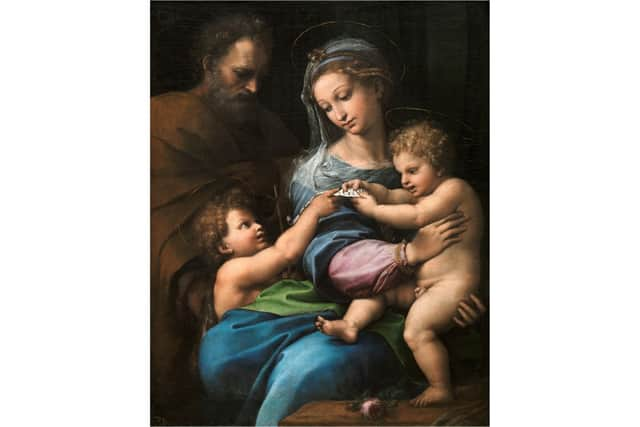This Raphael painting was not entirely the Renaissance master's work - AI study shows


New analysis by artificial intelligence is shining new light on a Renaissance master painter's work. AI has shown that a famous Raphael painting features a face that was not created by the man himself.
Experts from the Universities of Nottingham, Bradford and Stanford have used intelligence-based deep feature analysis on the Madonna della Rosa (Madonna of the Rose) and they have discovered that, while most of the painting is indeed by Raphael, the face of Joseph is most likely not by the same hand.
Advertisement
Hide AdAdvertisement
Hide AdThe della Rosa, which hangs in the Museo del Prado, Madrid, Spain, has intrigued art experts, with some - including Raphael scholar Professor Jurg Meyer zur Capellen - suggesting that Raphael's pupil Giulio Romano may have contributed. One theory is that the rose and the lower portion may have been painted by someone else. However, new analysis reveals the lower part of the painting is “most likely” by Raphael.
Professor Hassan Ugail, Director of the Centre for Visual Computing and Intelligent Systems at the University of Bradford, devised the algorithm which recognises authentic works by Raphael, with 98 per cent accuracy.
Professor Ugail said: “When you present an image to the computer, it will give a binary classification of whether it’s an authentic Raphael or not, with 98 per cent accuracy. Now we can say with great confidence whether a painting is an authentic Raphael or not.


"When we tested the della Rosa as a whole, the results were not conclusive. So, then we tested the individual parts and while the rest of the picture was confirmed as Raphael, Joseph’s face came up as most likely not Raphael."
Advertisement
Hide AdAdvertisement
Hide AdA peer-reviewed paper on the work, titled Deep Transfer Learning for Visual Analysis and Attribution of Paintings by Raphael, co-authored by Professor Ugail, Professor Brooke, Professor Howell Edwards (Emeritus Professor of Molecular Spectroscopy, University of Bradford), and Stanford University Adjunct Professor David G. Stork has been published in Heritage Science journal. The research team has previously used artificial intelligence-assisted computer-based facial recognition on a mystery painting known as the de Brécy Tondo, which bears a resemblance to Raphael’s Sistine Madonna. The computer determined it was a work by Raphael, building on previous pigment analysis by Professor Howell Edwards, also at the University of Bradford, which placed it firmly in the Renaissance era. Explaining more about the history of the Madonna della Rosa, Howell Edwards, Emeritus Professor of Molecular Spectroscopy at the University of Bradford, added: "Painted on canvas around 1517/18, the Madonna della Rosa was regarded by early connoisseurs as a Raphael autograph, ie he painted 100 per cent of it. From the mid 1800s, the art historian Johann David Passavant and others questioned its composition and preferred to attribute its execution partially to Raphael and partially to his workshop.
"The AI programme analysis of our work has demonstrated conclusively that whereas the three figures of the Madonna, Christ Child and St John the Baptist are unequivocally painted by Raphael, that of St Joseph is not and has been painted by someone else – possibly by Romano, as believed by zur Capellen and others."
Dr Christopher Brooke, Honorary Research Fellow at the University of Nottingham, added: "This analysis of art works by the artist Raphael presents an objective and quantifiable approach, using machine learning, to the classification of painted imagery.
"It promises to be a useful, additional tool in future investigations of this nature, alongside well-established methods such as spectroscopy. It is adaptable in that works by other artists may be examined using the same technique, and this is the goal of future research."
Advertisement
Hide AdAdvertisement
Hide AdStanford University Adjunct Professor David G. Stork is a pioneer in the application of computer vision to problems in the history and interpretation of fine art paintings and drawings, also contributed to the recent research. He said: "Computer methods are slowly but surely proving they can aid traditional humanistic studies of art, but they must always be employed with a deep understanding of art historical context, and their results understood and interpreted in the broader context of art knowledge relevant to the problem at hand.
Comment Guidelines
National World encourages reader discussion on our stories. User feedback, insights and back-and-forth exchanges add a rich layer of context to reporting. Please review our Community Guidelines before commenting.
